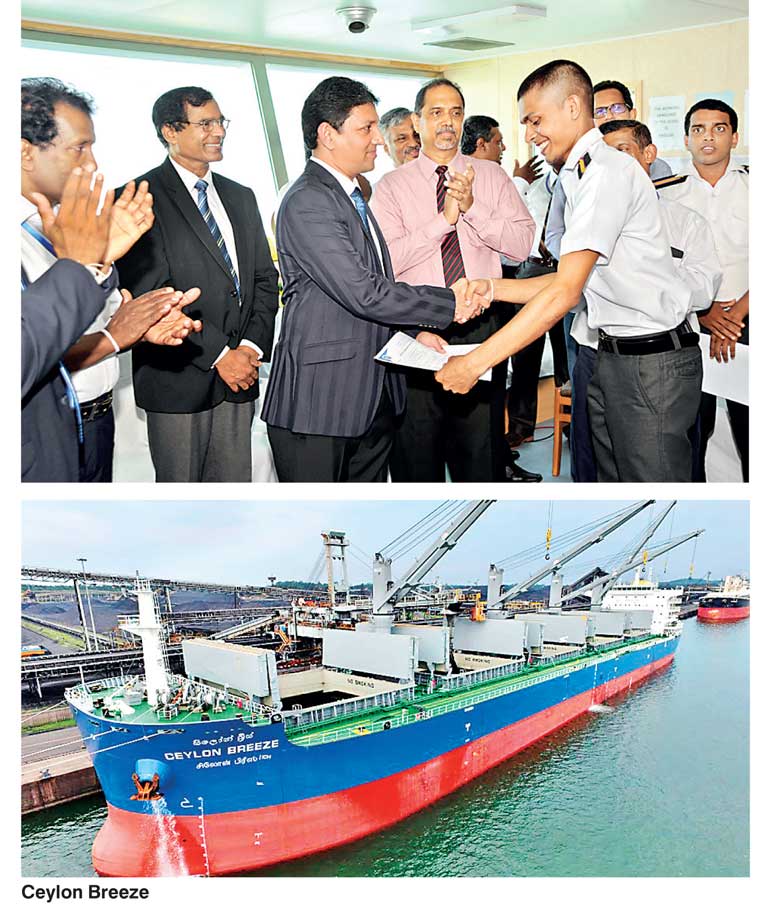Friday Dec 05, 2025
Friday Dec 05, 2025
Monday, 16 May 2016 00:00 - - {{hitsCtrl.values.hits}}
 Ceylon Shipping Corporation Ltd. reaches a new milestone in its history by expanding its fleet by two bulk vessels with a dead weight of 63,000 metric tons each. The ship building contract was entered with AVIC International Beijing Company Ltd. in China in 2014.
Ceylon Shipping Corporation Ltd. reaches a new milestone in its history by expanding its fleet by two bulk vessels with a dead weight of 63,000 metric tons each. The ship building contract was entered with AVIC International Beijing Company Ltd. in China in 2014.
Both vessels are fully equipped with modern technology and more fuel efficient than average vessels of this size traversing the world’s ocean today. The vessels have been designed to load bulk commodities like coal, cement, wheat, grain, fertiliser, iron ore, etc.
These two ships have been designed to cater to the need of coal transportation as well as to provide training for national trainee-cadets with berths on one whole deck that could accommodate up to 26 cadets at any given time.
The main objective of building these two vessels is to facilitate coal operation in Puttalam for the Lakvijaya thermal power station and Sampur, Trincomalee once the second thermal power station starts its operations.
In the 44-year history of CSC, it has functioned as ship owners, operators, charterers and ship managers in carriage of both bulk and containerised cargo all over the world, challenging and competing with major shipping lines with trade restrictions and economic impacts concerning national interest of the country.
The growing needs of the country and volatile business environment in containerisation resulted in CSC turning to the profitable market environment in the bulk sector. The construction of two bulk vessels is the initial step of expanding its bulk fleet as the two vessels alone will not be sufficient to fulfil even a quarter of the annual requirement of coal to the country. Therefore, CSC has an opportunity to facilitate the coal supply through strategic partnerships with ship owners by adding more bulk vessels to meet the national coal requirement.
The first vessel, Ceylon Breeze, had its steel cutting ceremony in September 2014 and keel laying in December 2014. The launching ceremony equates to the birth of a child where a vessel that has been constructed is nearly complete, is safe to float in the water and refers to the actual process of floating the vessel in the water. The first vessel launching ceremony was in August 2015 in the presence of CSC officials.
The delivery of the first vessel was taken on 20 January 2016. She is 199.826 metres long, 32.249 metres wide and has a carrying capacity of 63,329 MT. This is presently the largest vessel ever to be owned by Sri Lanka.
The ceremonial acceptance of Ceylon Breeze by her motherland was held on 15 March at the Port of Colombo on her way to Puttalam in the presence of higher officials of the organisation and dignitaries of ministries. The vessel was on her maiden voyage with a load of 55,000 MT of coal from Voshtochny, Russia to Norochcholai Thermal Power Plant. During this ceremony 12 Sri Lankan cadets who passed out from the University of Moratuwa and TTI Katunayake joined the ship Ceylon Breeze.
Ceylon Shipping Corporation places heavy emphasis on recruiting qualified, well-trained and experienced crew to its new bulk ships and has enrolled 22 crew members to the first vessel. Interestingly, the majority of them are ex-CSC crew who have passed out as cadet officers on CSC’s own vessels.
Whilst the first vessel is already engaged in coal transportation and just completed her second voyage after discharging a coal shipment of 61,520 MT carried from RBCT, South Africa, the second vessel is under construction in the same ship yard in China.
The steel cutting of the second vessel, Ceylon Princess, was in October 2014, keel laying was in July 2015 and the launching of the second bulk vessel was in April 2016. She will be delivered at the end of July/August.
The two new bulk vessels will be deployed for coal transportation until the South West monsoon starts in May and will be employed in more profitable areas till the end of the monsoon period in August each year.
According to the CSC, its biggest challenge apart from the low trend in freight market is to meet the loan repayments starting from August 2016 to People’s Bank at a very high rate of interest. This of course has made further challenging due to the purchase price of ships which is believed to be $ 7.5 m to $ 8 m more than the market price of a Panamax size bulk ship ($ 16.0 m to $ 15.0 m extra for both). Those could have been two controllable factors at that time of entering into contracts in 2014, in the backdrop of the state of the global freight market remaining an unpredictable and uncontrollable factor.